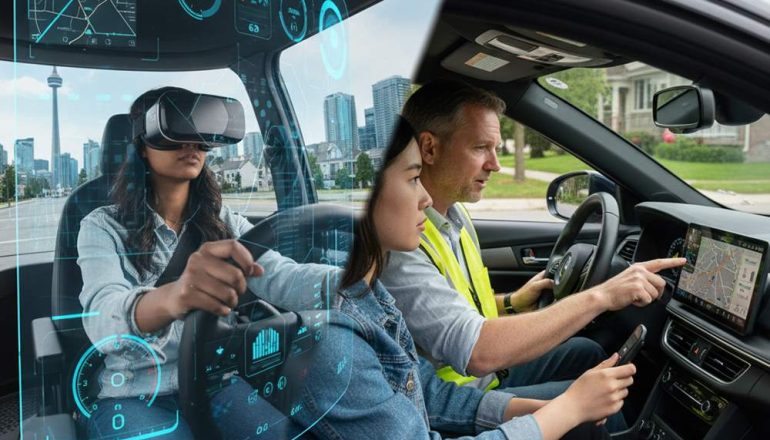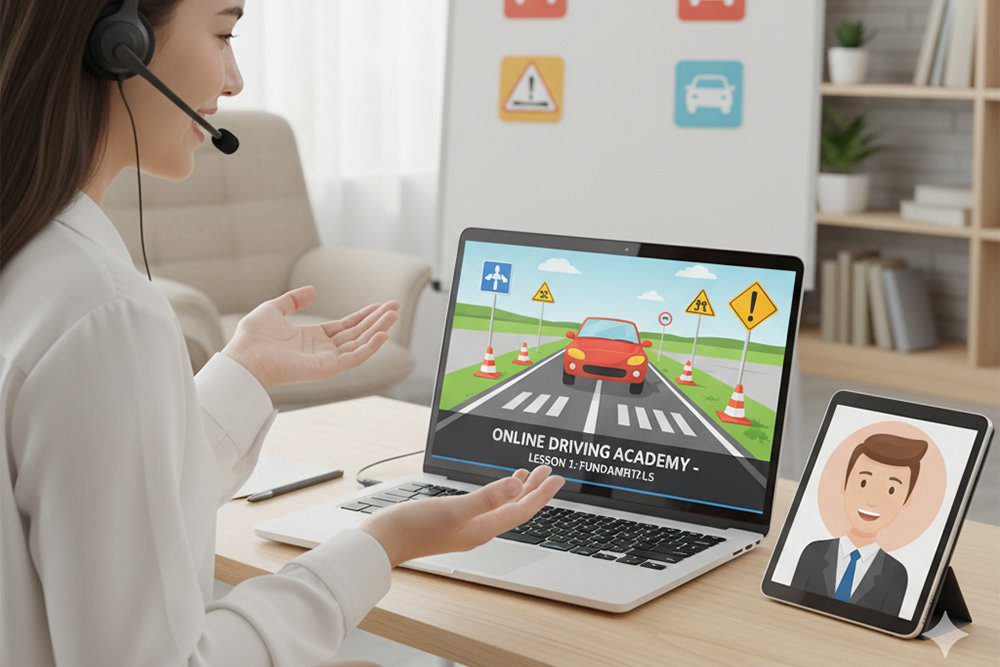Learning to drive has evolved significantly in the past decade. In Ontario, modern driving schools are increasingly turning to technology to improve the way students learn, practice, and prepare for safe driving. From simulators to digital platforms, today’s training methods are far more interactive and effective compared to traditional lessons. This transformation not only makes learning easier for students but also ensures safer roads for everyone.
In this blog, we’ll explore how driving school technology is reshaping driver education across Ontario, why it matters, and how it benefits new drivers.
The Evolution of Driver Education in Ontario
Traditionally, driving lessons were centered on classroom lectures and behind-the-wheel practice with an instructor. While these methods remain essential, they have limitations: students sometimes find it difficult to visualize scenarios, practice in risky conditions, or retain theoretical knowledge.
With the rise of digital driver education, driving schools in Ontario began to integrate modern tools into their teaching. This change accelerated in recent years, especially as students sought more flexible, accessible, and effective ways to learn. Today, a combination of classroom instruction, online platforms, and cutting-edge simulation ensures that learner drivers receive a more complete education.
Online Driving Lessons in Ontario
One of the biggest advancements has been the availability of online driving lessons that Ontario learners can access from home. These digital courses cover the theory portion of driver training, such as traffic laws, road signs, defensive driving strategies, and accident prevention.
Instead of sitting in a classroom for hours, students can now log into an interactive platform and complete lessons at their own pace. Many courses use videos, animations, and quizzes to keep learners engaged. For busy students or working professionals, this flexibility is invaluable. Moreover, online lessons often include progress tracking, enabling both students and instructors to monitor performance and areas that need more focus. This data-driven approach makes learning more personalized and efficient.
Simulator Training in Canada
While nothing can replace actual driving, simulator training Canada programs have become a game-changer in modern driving schools. Advanced simulators recreate real-life road conditions in a safe, controlled environment. Students can practice driving in rain, snow, fog, or nighttime without the risks associated with real-world driving.
In Ontario, where weather conditions can change drastically, this feature is particularly valuable. Simulators help learners experience difficult scenarios—like icy roads or sudden obstacles—without putting themselves in danger. This prepares them mentally and physically to handle real-world challenges once they start driving on actual roads.
Simulator training also provides instant feedback. If a student makes a mistake, the system highlights the error immediately, allowing for correction and reinforcement. This speeds up the learning curve and reduces the likelihood of developing bad driving habits.
Driving School Technology: Making Training Smarter
The integration of driving school technology goes beyond just online lessons and simulators. Modern Ontario schools are embracing a range of tools to enhance student success.
1. Mobile Apps for Learning
Many schools now provide companion apps where students can review materials, practice mock tests, and schedule driving lessons. These apps also send reminders, ensuring that students stay on track.
2. Virtual Reality (VR) Experiences
Some driving schools are experimenting with VR headsets to offer an even more immersive training experience. These setups allow learners to virtually sit in a car, look around, and respond to realistic scenarios.
3. Telematics and Data Tracking
In-car technology, such as telematics devices, helps track driving performance during lessons. These systems record speed, braking, steering, and other data, which instructors review with students to identify areas for improvement.
4. Video Dashcams for Feedback
Dashcam recordings are increasingly used as teaching aids. After a lesson, instructors and students can review video footage together to analyze mistakes, highlight good practices, and discuss improvements. Together, these innovations ensure that driving school technology supports students in building both knowledge and confidence before they attempt Ontario’s road tests.
The Role of Digital Driver Education
Digital driver education combines online learning, mobile apps, and digital assessments into a streamlined system. It not only enhances convenience but also standardizes training quality across Ontario.
For example, students who live in smaller towns without access to large driving schools can still benefit from high-quality instruction through online modules and remote coaching. Additionally, digital platforms often include interactive games and scenario-based training, making learning more engaging.
Parents and guardians can also track their child’s progress, ensuring accountability and encouraging consistent practice. This collaborative approach ensures that learners aren’t just preparing for their G1 or G2 test but are developing skills for long-term safe driving.
Benefits of Technology in Driving Schools
The adoption of driving school technology provides several clear advantages:
- Flexibility and Accessibility – Students can complete theory lessons online at their own pace, reducing scheduling conflicts.
- Safety in Training – Simulators allow learners to practice high-risk scenarios safely.
- Improved Engagement – Digital lessons and VR keep students more focused compared to traditional lectures.
- Data-Driven Progress – Performance tracking helps instructors personalize training.
- Confidence Building – By practicing online and in simulators before hitting the road, students gain more confidence during real driving lessons.
Challenges and Considerations
While technology has improved driver training, it’s not without challenges. Some students may rely too heavily on online or simulator learning without enough real-world practice. Instructors must balance digital tools with practical experience on Ontario roads.
Additionally, access to technology may vary—students in rural areas might face connectivity issues, and not every school has the budget to implement high-end simulators or VR. However, as technology becomes more widespread, these barriers are likely to decrease.
The Future of Driving Education in Ontario
Looking ahead, driving education in Ontario is expected to become even more digital. Artificial intelligence (AI) may play a larger role, offering real-time adaptive feedback during both online courses and in-car practice.
Self-driving car technology could also influence how future lessons are taught, with a greater emphasis on driver awareness, monitoring autonomous systems, and emergency interventions. Regardless of these changes, the human element—qualified instructors—will always remain essential.
By combining skilled teaching with innovative tools, Ontario’s driving schools will continue to set high standards for safe and effective driver education.
Final Thoughts
Modern driving schools in Ontario are no longer limited to textbooks and practice cars. They’re using technology to provide flexible, safe, and engaging training experiences for students. With online driving lessons in Ontario making theory accessible, simulator training in Canada providing safe practice, and digital driver education creating personalized learning paths, today’s learners are better prepared than ever.
As driving school technology continues to evolve, students can look forward to even more innovative ways to learn, practice, and become confident, responsible drivers on Ontario’s roads.
FAQ’s
Q1. How is technology used in driving lessons?
A: Technology is used through simulators, online lessons, mobile apps, telematics, and VR. These tools provide safer practice environments, flexible learning, and data-driven feedback for better results.
Q2. Do online driving courses help students pass faster?
A: Yes. Online driving courses allow students to study at their own pace, practice theory more effectively, and reinforce lessons through digital tools, often resulting in faster preparation for exams.





